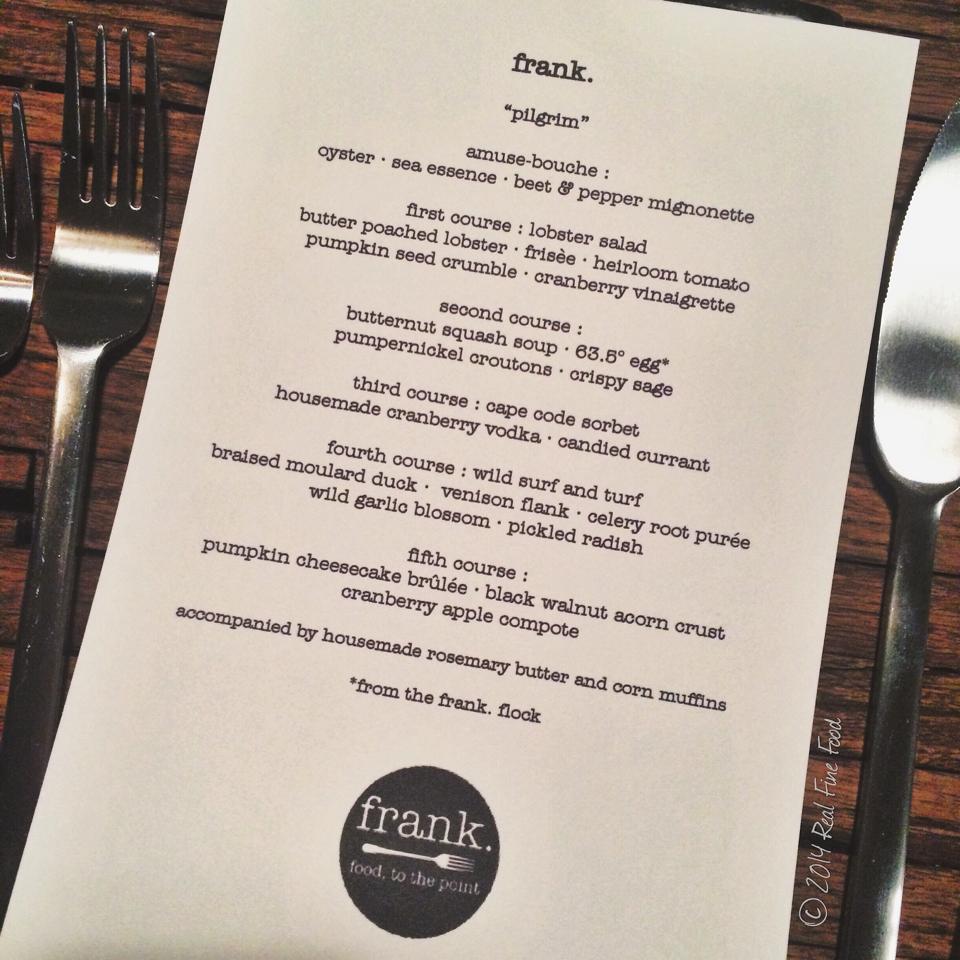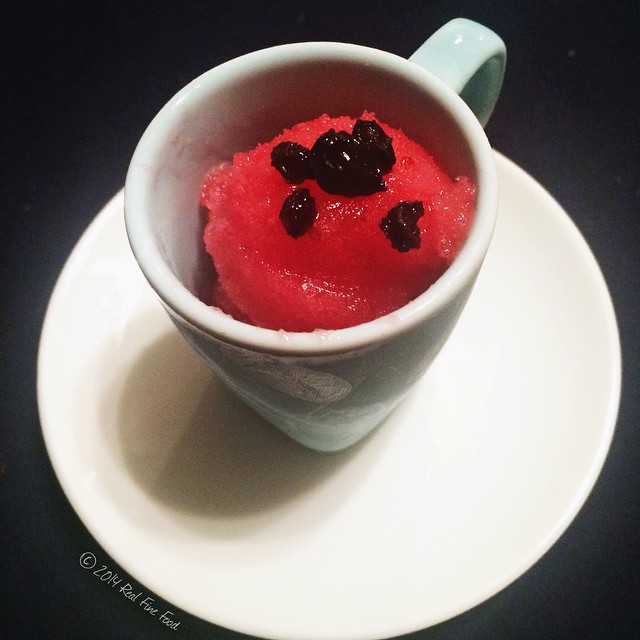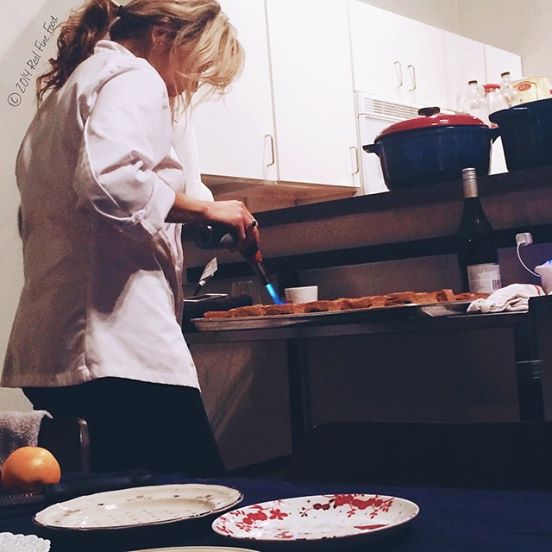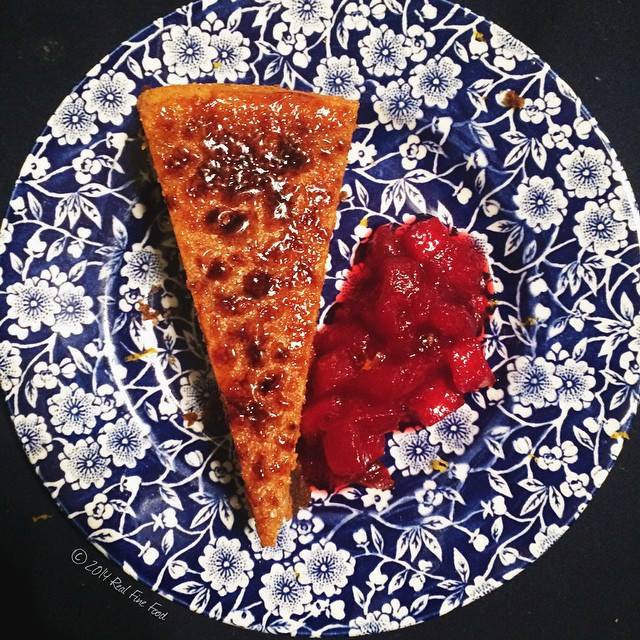(Please note, photos in this blog post appear courtesy of Stephanie Casey from Real Fine Food. Thanks, Stephanie!)
Thanksgiving was coming quickly on our heels, and Jennie and I decided to visit a theme we had tossed around for a couple of years…the original Thanksgiving dinner. Many of us think of the story of Thanksgiving as a myth. “The Pilgrims and the Indians held hands and had a feast together.” I guess we think of this because of the horrific woes the European settlers wreaked upon the Native American population, both inadvertently through disease, and intentionally through violence, slavery, and land theft. But the truth is that the earliest settlers, the Puritan Pilgrims, lived at peace with their neighbors, the Wampanoag tribe…and it was thanks to the Wampanoag that those first settlers even survived in the first place.
The Pilgrims experienced devastating loss during their first winter in 1621. They were in an unfamiliar land with unfamiliar plants and animals, and more than half of them died during their first year in the New World. The Wampanoag took pity on them and taught them which native plants could be used for both food and medicine, and taught them their time-honored farming traditions for raising bizarre new foods like corn, squash, and beans, which the Europeans had never seen before.
Come harvest time in the fall of 1621, the provincial governor, William Bradford, decreed that the 50 remaining Pilgrims share a magnificent 3-day harvest feast with their Wampanoag neighbors…which is where our Thanksgiving tradition comes from. (Though their feast undoubtedly occurred in late September or early October around harvest time in Massachusetts…by late November when we celebrate it now, the frosts have arrived and harvest time is long past.) We actually have a roster of the names of those who attended that first Thanksgiving. So it’s no myth!
What IS certain is that there wasn’t turkey and dressing, macaroni and cheese, and cranberry sauce on that first table. We have only snippets about the actual menu, but enough to know that their feast was drastically different than what we eat today to celebrate. So Jennie and I wanted to take that list, along with the knowledge of what foods were readily available to the Pilgrims and Wampanoag, and put together a feast inspired by that first Thanksgiving. And here’s what we came up with:

There’s a big hole in our modern Thanksgiving meal, and that’s seafood. Yes, in the northeast, some folks eat oyster dressing with their turkey. But seafood made up a majority of the protein in the diets of the Pilgrims and the Natives, and was definitely present on the first table…namely oysters, which were easily foraged in the shallow waters near Cape Cod and the Plymouth colony. Chef Adrien Nieto took control of this course, as he’s a great oyster lover, and conceived this mouth-watering sauce to give the oyster amazing flavor and texture…a beet mignonette. Mignonette (MIN-yun-ET) is a classic sauce for raw oysters, normally consisting of shallot and vinegar. Adrien expanded that with tiny cubes of just-roasted beet and champagne, for explosive color and texture. He also created something he calls “sea essence” by boiling clams to get their broth, making lobster stock with the shells left over from a subsequent course, and reducing both the clam and lobster stock until it was nearly thick, adding a bit of dashi (fish and seaweed broth) and scallop concentrate, until a single drop tasted like all the seafood in the ocean crammed into your mouth at once. And a single drop was added to each oyster…served up with a glass of champagne. (Though the Puritans didn’t drink much wine.) This was probably the most beautiful oyster presentation I’ve ever seen, and definitely the tastiest:

On to the first course…with more seafood! Lobster. Believe it or not, lobster used to be considered “poor man’s food,” since they were so easy to catch. It was famine food. And let’s be honest…most of us only love lobster because it’s considered a luxury food. I mean…come on, lobster is tough, stringy, and not all that delicious. Compare its texture and flavor to crab or scallop, and there’s just no way it can hold up. I’m not sure how lobster climbed the ladder from a seafood-of-last-resort to the penultimate swanky seafood, but somehow it did. Nevertheless, lobster was a staple of the early Pilgrim diet, so it had to be on the menu. In the form of a lobster salad, in this case. We butter poached our lobsters using the “sous vide” technique…they were sealed in a vacuum bag with tons of butter, and cooked gently in a warm water bath for 45 minutes until they were perfectly done all the way through. (And we used small tails, because no matter how you cut it, those popular and ruinously expensive giant lobster tails can NEVER be made fork-tender!) Smaller is ALWAYS better when it comes to lobster. Our lobster sat atop a salad of beautiful frisée, a decorative lettuce that is technically an endive (and part of the daisy family), dressed with a cranberry vinaigrette. Only two native berries were widely common and harvestable in fall near the colony…cranberries and currants. (More on currants later.) Cranberries themselves were likely too sour to be considered for everyday use by the Pilgrims, with foraged honey being the only practical source of sweetening, but are probably the one mainstay that held over in our modern Thanksgiving dinners. I adore cranberries and use them fresh as often as I can during the narrow window when they pop up in grocery stores. We also had some candied pumpkin seeds in the salad, as well. The Wampanoag taught the Pilgrims to raise various squashes, which could be stored through the winter, and their seeds were a rich source of protein and oil and were easily preserved, so pumpkin seeds would have definitely been an important food source during the early years.

Soup! My favorite food. And when it starts getting cold, my soup stomach starts getting bigger and demanding more and more. We chose butternut squash as the basis for our soup…another hard squash that has an incredibly long shelf life. (Note: the butternut squash was “developed” in the early 1900s in Massachusetts through a cross-breeding program, and didn’t exist in this exact form in the 1600s, but all squashes originated in the Americas, were originally cultivated by Native tribes here, and spread from here to the rest of the world.) Our butternut squash soup was rich with homemade buttermilk and a bit zesty with ginger. We made some pumpernickel croutons to add texture, and plopped in our signature 63.5° egg from our flock of chickens…which takes any soup from great to over-the-top. (The 63.5° egg is cooked at 63.5C or 146.3F for one hour in its shell…this keeps the egg right at the temp when its proteins begin to solidify, but not so high that the white becomes rubbery and the yolk becomes chalky, so you end up with a silken, custardy egg where the white and the yolk are the exact same texture. It’s crazy good.) Toss a crispy fried sage leaf on top, and you’ve got an epic soup for a cold autumn day.

It is certain that the Pilgrims didn’t eat a lot of sorbet during those first few years. Native fruits weren’t common, and neither was refrigeration. However, while we now consider ice cream and sorbet as summer treats, in the old days the only time these treats could be enjoyed was when ice/snow could be had in the front yard…meaning ice cream was always a winter dish until the advent of refrigeration. While we were muddling over what Pilgrim-inspired flavors to use, our “GM” Chris Michaels suggested a Cape Cod sorbet, which made perfect sense. Not only was the landing of the Mayflower in the shelter of Cape Cod near Plymouth Rock, its signature ingredient is the cranberry…one of the 2 native berries that could be foraged in the autumn. The “Cape Codder” cocktail of vodka and cranberry was invented in the 1940s by the Ocean Spray corporation to promote the drinking of cranberry juice, and at that time it was called the “Red Devil.” How it changed to “Cape Codder” is lost to time. We made ours by pureeing fresh cranberries with vodka and a bit of lemon juice, and freezing it. Most of the time at FRANK when we serve a boozy sorbet, we cook down the liquor for two reasons: for one, it concentrates the flavor of that liquor, and also it removes some of the ethanol that freezes at a much lower temperature than water. (Contrary to popular believe, it’s not possible to completely boil the alcohol out of ANYTHING…wine, beer, or liquor. However, you can reduce the amount of ethanol to such a small state that it won’t intoxicate children.) It’s REALLY hard to freeze a high-proof liquid. Ever put a bottle of vodka in your freezer? It just gets thick, but doesn’t actually freeze. And it’s no use reducing vodka to concentrate its flavor, because it has no flavor. So we simply froze our vodka/cranberry concoction using dry ice, which has a temperature of -109°F. (Pure ethanol doesn’t freeze until -178°F, but vodka is only 40% ethanol and freezes at -16°F…beyond the capacity of most ice cream makers but quite easily frozen with dry ice.) We topped our sorbet with candied currants. Currants are one of those things that lots of us are unfamiliar with. (True native American currants are actually gooseberries which grow wild on bushes and do NOT have the papery husk associated with “Cape gooseberries,” which are not gooseberries at all, and are named after the Cape of Good Hope in South Africa, rather than Cape Cod. Whew!) These berries ripen in the fall and provided an important forageable food source for the Native Americans and the Pilgrims, and could easily be dried to preserve them. Commercially available “Zante currants” are actually a type of tiny dried grape, and aren’t currants at all. But unless you can forage them yourself on the east coast in the fall, Zante currants are what you have to resort to! We candied ours by simmering them in rum and bourbon with sugar, cinnamon, clove, and nutmeg until they had absorbed all that yummy goodness, and this is one of the more popular sorbets we’ve ever served:

And now for the main attraction! It’s likely that wild turkey DID make appearance at the first Thanksgiving feast, as the provincial governor recorded: “And besides waterfowl there was great store of wild turkeys, of which they took many…” However, wild turkey is certainly not the most delectable of wild birds, and the governor mentions waterfowl first. ie…DUCK! So we elected to have duck as one of the proteins on the plate, as the Pilgrims hunted the duck for the table. The Wampanoag made their contribution to the feast, as well: “…many of the Indians coming amongst us…with some ninety men…and they went out and killed five deer, which they brought to the plantation and bestowed on our governor.” So we knew there had to be venison on the plate, as well. We opted for a two-meat plate, with duck leg and thigh meat braised slowly in wine overnight with root vegetables, and venison flank, which requires very delicate preparation to be delicious. Most venison meat, including the flank, is ground into sausage and mixed with pork fat and seasonings, because it’s REALLY hard to make any part of venison but the tenderloin/backstrap edible as a standalone meat. This is because venison is incredibly lean…there’s almost no intramuscular fat at all, and the muscles that get used the most (leg, abdominal muscles, ie flank) tend to be very gamey along with being famously tough. There’s a way around this, if you have an immersion circulator for sous vide cooking! First, you brine the venison in buttermilk to add seasoning and moisture, and to draw out a bit of the gaminess. Then you vacuum seal the venison with some bacon fat and seasonings, and cook at exactly medium rare temperature (130°F at FRANK) in that controlled water bath for 36 hours. That lengthy cooking time breaks down all the tough connective collagen in the flank, turning it into moist, unctuous gelatin. (The same way that a long, slow smoke turns brisket moist and tender.) But whereas smoking keeps the temperature in the 180°-225°F range, the immersion circulator lets us keep that venison at exactly medium rare temp, so it NEVER overcooks…it just gets tender. Then we cool the flank, give it a quick sear in cast iron to get a crust, and you’ve got fork-tender, flavorful venison flank…something that few people have ever experienced.
We chose to nestle our lovely meats on a bed of celery root purée. Never tasted celery root, also known as celeriac? You’re not alone. But I can’t, for the life of me, understand why. Celery root is the most delicious of ALL the root vegetables. Everyone I’ve ever introduced it to has been smitten. It’s a variety of celery, but not the type whose stalks you buy in the grocery store. The root is tender and crisp, and can be eaten raw or cooked. The flavor is unmistakeably celery, but the texture is all its own. Roast it, and it becomes sweet and nutty, but the celery flavor is most pronounced when raw or when simmered gently with cream and butter…the way we did it. We completed this “simple” dish with some pickled radish and wild garlic blossoms, and it was lovely and delicious:

We accompanied these courses with corn muffins, corn being a staple ingredient of most Native American tribes. They cultivated this unique species of giant grass, native to Central America and spread north to the other tribes through trade, as its seeds could be dried and preserved throughout the winter. The Pilgrims had never encountered corn in their lives until the Wampanoag famously introduced them to both it, and their special cultivation method which involved placing dead fish in the hole with the seeds to nourish them as they grew. We churned a housemade butter and folded in fresh rosemary to smear onto the muffins. Corn bread would have been the only realistic type of bread available to the colonists until they began cultivating wheat several years after arrival.
For dessert we decided to revisit pumpkin, and ended up fighting about whether it should be crème brûlée or cheesecake. Dairy was rare in the early days of the colony, but we had to end our feast in a decadent way, so we cheated a bit on that one. And on the fact that pumpkin was a savory ingredient until centuries later…pumpkin pie was probably invented by the British or French after hard squashes migrated from this continent to theirs. But we were less concerned about that than about whether we should serve crème brûlée or cheesecake. And that’s when GM Chris suggested, “Why not brûlée your cheesecake?”
STROKE
OF
GENIUS

We THOUGHT we had invented something extraordinary, but turns out a few recipes do exist. We’re just gonna pretend otherwise, though, as how often do you encounter brûléed cheesecake?!? Feeling slightly guilty about the near complete departure from history on the dessert, I set out to create a crust for this cheesecake made from forageable foods, rather than the traditional graham cracker crust. (Though Jennie was adamant that it have the crunch of a graham crust!) I knew from previously working with acorns that they have an incredible crunch and would be just the ticket…though acorns are a nightmare to process into edible form. First you, have to harvest and shell the acorns. Then blend them with water into a mush, then boil the mush, let it soak to extract the bitter tannins, then boil and soak again, until the mush no longer has the fuzzy, bitter tannin taste. Then you spread the mush into a thin layer on a baking sheet and bake gently until it’s totally dry. A LOT of work. But the texture that acorn meal contributes to any baked good is truly extraordinary, so it’s worth the effort for special occasions. We combined the acorn meal with chestnut flour (also a native nut), and black walnut…which is an extraordinary and fairly rare ingredient. The vast majority of walnuts you eat are European walnuts. Our native black walnut is something completely different, with a shell so hard it’s nearly impossible to crack, and a nut that can’t be removed in large pieces…tiny fragments must be picked out carefully. But the FLAVOR! And aroma. Opening a bag of black walnuts and inhaling deeply will puzzle you, for the scent is more floral and fruity than nutty. It’s hard to find real black walnuts…we were able to source them on Amazon. This crust was completely gluten free, just by coincidence, but easily the most flavorful cheesecake crust I’ve ever tasted. Jennie brûléed the cheesecake with raw sugar to give it that same crust you get with crème brûlée. And we served it with a luscious cranberry apple compote…also known as my legendary cranberry sauce, which is not only a fabulous Thanksgiving side dish, it can be used to top pancakes or stuff crepes, over ice cream, or in any number of applications. It was a truly epic dessert:

A fabulous time was had by all, and this was one of our most educational menus yet. Thanks for reading, and we hope to see you at our FRANK table soon!

Leave a Reply
You must be logged in to post a comment.